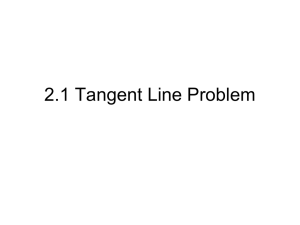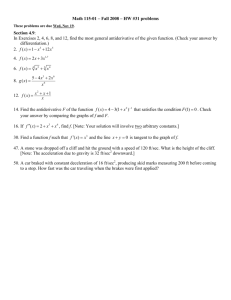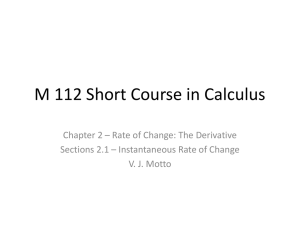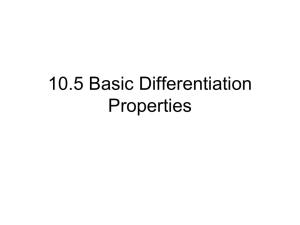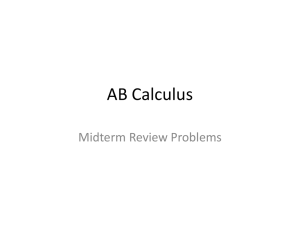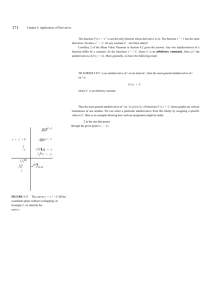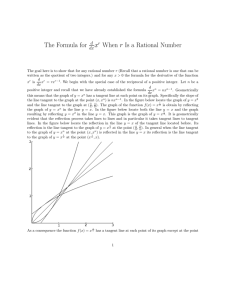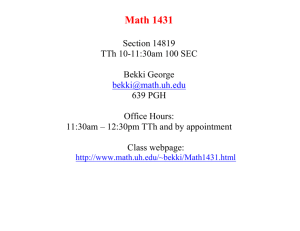Notes 15.2
advertisement
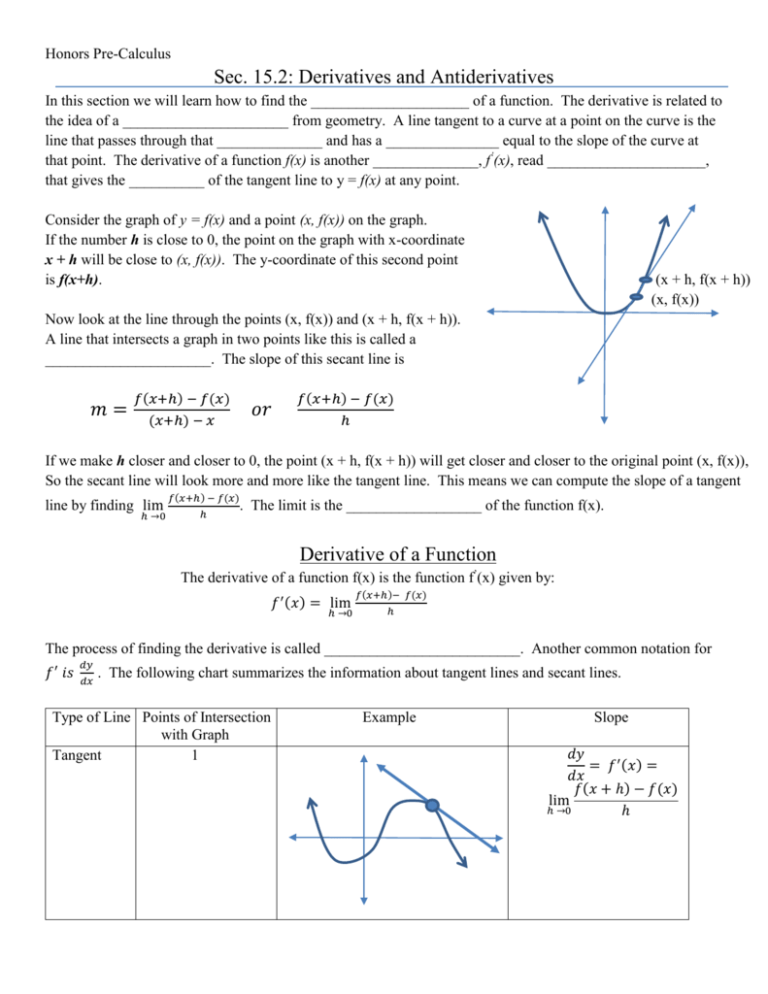
Honors Pre-Calculus Sec. 15.2: Derivatives and Antiderivatives In this section we will learn how to find the _____________________ of a function. The derivative is related to the idea of a ______________________ from geometry. A line tangent to a curve at a point on the curve is the line that passes through that ______________ and has a _______________ equal to the slope of the curve at that point. The derivative of a function f(x) is another ______________, f’(x), read _____________________, that gives the __________ of the tangent line to y = f(x) at any point. Consider the graph of y = f(x) and a point (x, f(x)) on the graph. If the number h is close to 0, the point on the graph with x-coordinate x + h will be close to (x, f(x)). The y-coordinate of this second point is f(x+h). (x + h, f(x + h)) (x, f(x)) Now look at the line through the points (x, f(x)) and (x + h, f(x + h)). A line that intersects a graph in two points like this is called a ______________________. The slope of this secant line is 𝑚= 𝑓(𝑥+ℎ) − 𝑓(𝑥) (𝑥+ℎ) − 𝑥 𝑜𝑟 𝑓(𝑥+ℎ) − 𝑓(𝑥) ℎ If we make h closer and closer to 0, the point (x + h, f(x + h)) will get closer and closer to the original point (x, f(x)), So the secant line will look more and more like the tangent line. This means we can compute the slope of a tangent line by finding lim ℎ →0 𝑓(𝑥+ℎ) − 𝑓(𝑥) ℎ . The limit is the __________________ of the function f(x). Derivative of a Function The derivative of a function f(x) is the function f’(x) given by: 𝑓 ′ (𝑥) = lim ℎ →0 𝑓(𝑥+ℎ)− 𝑓(𝑥) ℎ The process of finding the derivative is called __________________________. Another common notation for 𝑓 ′ 𝑖𝑠 𝑑𝑦 𝑑𝑥 . The following chart summarizes the information about tangent lines and secant lines. Type of Line Points of Intersection with Graph Tangent 1 Example Slope 𝑑𝑦 = 𝑓 ′ (𝑥) = 𝑑𝑥 𝑓(𝑥 + ℎ) − 𝑓(𝑥) lim ℎ →0 ℎ Secant 2 𝑚= 𝑓(𝑥 + ℎ) − 𝑓(𝑥) ℎ Example 1: A) Find an expression for the slope of the tangent line to the graph of 𝑦 = 2𝑥 2 − 3𝑥 + 4 at any point. That is compute 𝑑𝑦 𝑑𝑥 . B) Find the slopes of the tangent lines when x = -1 and x = 5. To find derivatives of polynomials, you can use the following rules. Derivative Rules Constant Rule: The derivative of a constant function is zero. If f(x) = c, then f’(x) = 0. Power Rule: If f(x) = xn, where n is a rational number, then f’(x) = nxn-1. Constant Multiple of a Power Rule: If f(x) = cxn, where c is a constant and n is a rational number, then f’(x) = cnxn-1. Sum and Difference Rule: If f(x) = g(x) ± h(x), then f’(x) = g’(x) ± h’(x). Example 2: Find the derivative of each function. A) f(x) = x5 C) f(x) = 2x5 – x + 5 E) f(x) = (x + 1)(x2 – 2) B) D) f(x) = x3 + 2x f(x) = x6 – x5 + x4 Finding the _______________________ of a function is the inverse of finding the derivative. That is, instead of finding the derivative of f(x), you are trying to find a function whose derivative is ________. For a function f(x), the antiderivative is often denoted by ________. The relationship between the two functions is_________________. Example 3: Find the antiderivative of the function f(x) = 5x4. As with derivatives, there are rules for finding antiderivatives. Antiderivative Rules Power Rule: n If f(x) = x , where n is a rational number other than -1, the antiderivative is 𝐹(𝑥) = Constant Multiple of a Power Rule: 1 𝑛+1 𝑥 𝑛+1 + 𝐶 If f(x) = kxn, where n is a rational number other than -1 and k is a constant, the antiderivative is 𝐹(𝑥) = 𝑘 ∙ Sum and Difference Rule: Example 4: A) B) 1 𝑛+1 𝑥 𝑛+1 + 𝐶 If the antiderivative of f(x) and g(x) are F(x) and G(x) respectively, then the antiderivative of f(x) ± g(x) is 𝐹(𝑥) ± 𝐺(𝑥). Find the antiderivatives of each function. f(x) = 32x3 B) f(x) = 35x6 + 12x2 – 6x + 12 f(x) = x2(x2 + x + 3) In real world-problems the derivative is often called the ___________________ of the function, because it measures how fast the function changes.

